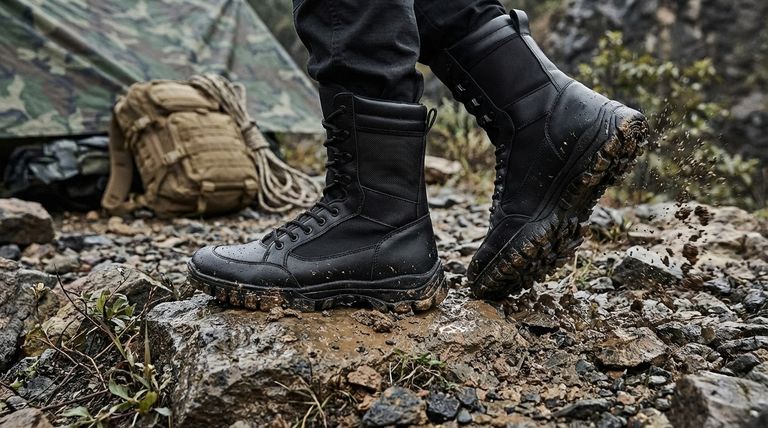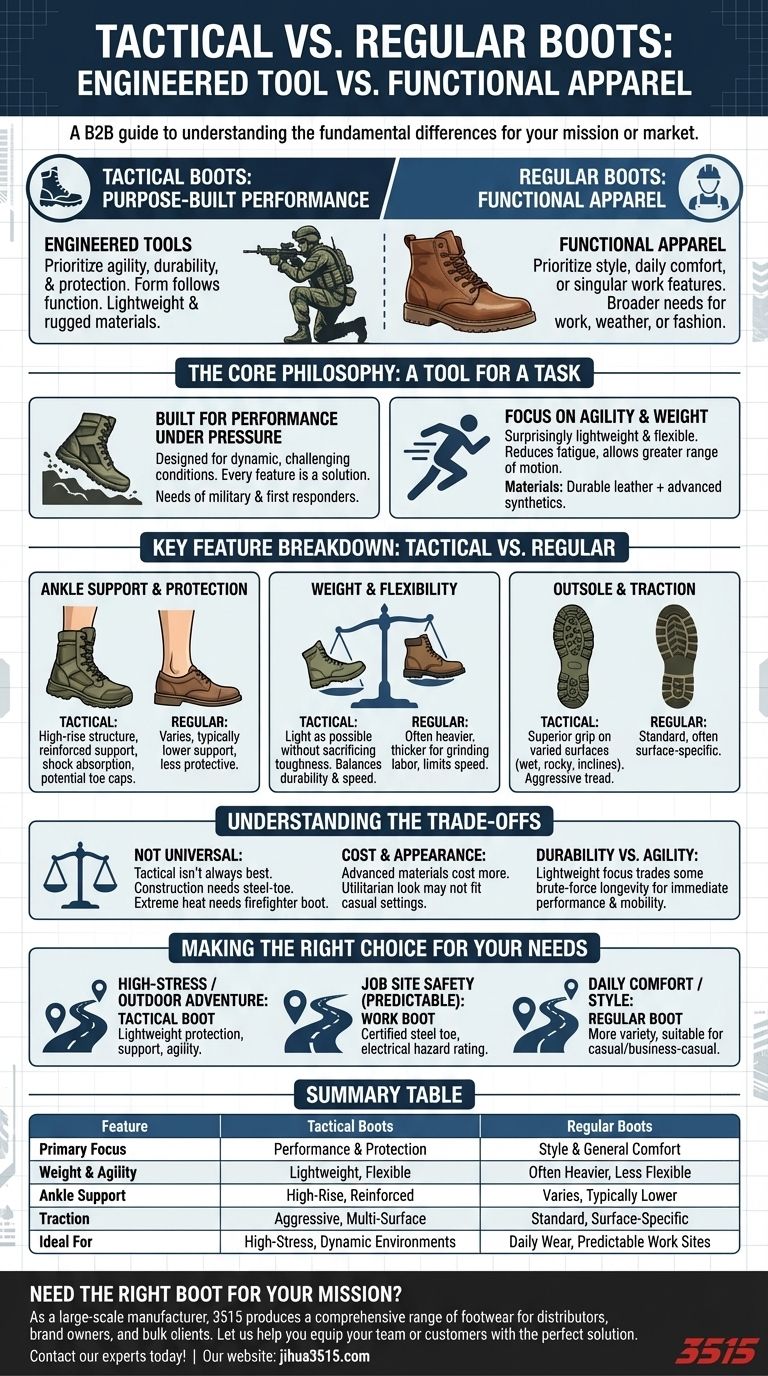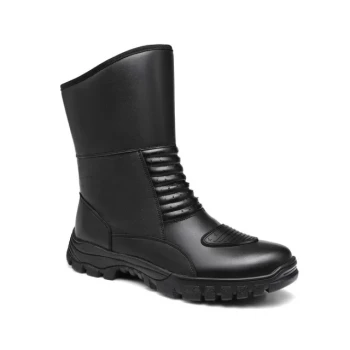In short, tactical boots are engineered tools while regular boots are functional apparel. Tactical boots are purpose-built for performance, prioritizing agility, durability, and protection for high-stress environments. They follow a "form follows function" design, using lightweight yet rugged materials, whereas regular boots often prioritize style, daily comfort, or singular work-specific features like a steel toe.
The fundamental difference isn't about one boot being "better," but about its intended mission. Tactical boots are designed for dynamic, challenging conditions where movement and protection are critical, while regular boots serve the broader needs of work, weather, or fashion.

The Core Philosophy: A Tool for a Task
The design of a tactical boot stems from the needs of military personnel, law enforcement, and first responders. Every feature is a solution to a potential problem encountered in the field.
Built for Performance Under Pressure
Tactical boots are created for users who may need to run, climb, or move quickly over rough terrain. This mission dictates every design choice, from the materials used to the construction of the sole.
A Focus on Agility and Weight
Unlike many traditional work or military boots that are heavy and rigid, tactical boots are often surprisingly lightweight and flexible. This design reduces fatigue and allows for a greater range of motion, which is critical in fast-paced situations.
Materials Engineered for the Environment
These boots frequently use a combination of durable leather and advanced synthetic fabrics like nylon. This blend provides ruggedness while maintaining breathability and reducing overall weight, often incorporating water-resistant properties.
Key Feature Breakdown: Tactical vs. Regular
The practical differences become clear when you compare the specific components of each boot type.
Ankle Support and Protection
Tactical boots typically feature a higher-rise structure and reinforced ankle support to prevent twists and injuries on uneven ground. They also incorporate shock-absorption technology in the sole and may have reinforced toe caps to protect against impacts. Regular boots may offer some support, but rarely to the same protective standard.
Weight and Flexibility
A key differentiator is the balance of durability and weight. A tactical boot is engineered to be as light as possible without sacrificing toughness. Many regular work boots, by contrast, are heavier and thicker, which provides durability for grinding labor but limits speed and agility.
Outsole and Traction
The outsoles on tactical boots are designed for superior grip across a wide variety of surfaces—from wet pavement and trails to rocky inclines. The tread patterns are often aggressive and multi-directional to ensure stable footing in unpredictable conditions.
Understanding the Trade-offs
Choosing a specialized tool always involves compromises. Tactical boots are no exception.
Not a Universal Solution
While versatile, a tactical boot is not always the best choice. For construction work requiring maximum crush protection, a dedicated steel-toe work boot is superior. For extreme heat, a firefighter's boot is the only safe option.
The Cost of Specialization
The advanced materials and construction that make tactical boots effective can also make them more expensive than many regular boots. Their distinct, utilitarian appearance may also not be suitable for casual or office settings.
Durability vs. Agility
The emphasis on keeping tactical boots lightweight means they may not have the same brute-force longevity as a heavier, traditional military or logging boot when subjected to constant, abrasive wear. They trade some long-term ruggedness for immediate performance and mobility.
Making the Right Choice for Your Needs
To select the right footwear, match the boot's design philosophy to your primary activity.
- If your primary focus is high-stress work or demanding outdoor adventures: A tactical boot's blend of lightweight protection, support, and agility is purpose-built for your environment.
- If your primary focus is job site safety in a predictable environment: A dedicated work boot with features like a certified steel toe or electrical hazard rating is the more appropriate and safer choice.
- If your primary focus is daily comfort, weather protection, or style: A regular boot offers far more variety and is better suited for casual or business-casual situations.
Ultimately, choosing the right boot means clearly understanding the job you need it to perform.
Summary Table:
| Feature | Tactical Boots | Regular Boots |
|---|---|---|
| Primary Focus | Performance & Protection | Style & General Comfort |
| Weight & Agility | Lightweight, Flexible | Often Heavier, Less Flexible |
| Ankle Support | High-Rise, Reinforced | Varies, Typically Lower |
| Traction | Aggressive, Multi-Surface | Standard, Surface-Specific |
| Ideal For | High-Stress, Dynamic Environments | Daily Wear, Predictable Work Sites |
Need the Right Boot for Your Mission?
As a large-scale manufacturer, 3515 produces a comprehensive range of tactical, work, and outdoor footwear for distributors, brand owners, and bulk clients. Whether you need agile tactical boots for demanding operations or durable work boots for job site safety, our production capabilities encompass all types of shoes and boots to meet your specific requirements.
Let us help you equip your team or customers with the perfect footwear solution.
Contact our experts today to discuss your needs!
Visual Guide

Related Products
- Durable High-Ankle Tactical Boots Wholesale Manufacturer for Custom & Bulk Orders
- Wholesale Tactical Boots High-Traction & Reflective for Bulk & Brand Orders
- Durable Leather Tactical Boots Wholesale & Custom Manufacturing for Brands
- Wholesale Waterproof Tactical Boots Custom Suede & High-Traction Soles
- Durable Leather High-Ankle Tactical Boots for Wholesale & Custom Manufacturing
People Also Ask
- What are the primary uses of tactical boots? Essential Footwear for Demanding Professionals
- How does the initial cost of tactical boots compare to regular shoes? Understand the Value Behind the Price
- How do tactical boots and regular shoes differ in cushioning and padding? Unlock the Key to Performance & Protection
- How does the material of tactical boots affect their performance? Choose the Right Material for Your Mission
- What does the upper part of a tactical boot cover? Your Guide to Protection, Fit, and Performance



















